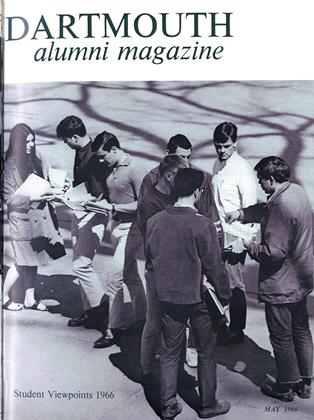ALEXANDER POPE. ELOISA TO ABELARD WITH THE LETTERS OF HELOISE TO ABELARD IN THE VERSION
MAY 1966 JOHN HURD '21ALEXANDER POPE. ELOISA TO ABELARD WITH THE LETTERS OF HELOISE TO ABELARD IN THE VERSION JOHN HURD '21 MAY 1966
BY JOHN HUGHES (1713).Introduction and Notes by James E. Wellington '48. Coral Gables: University ofMiami Press, 1965. 149 pp. $3.00.
Peter Abelard (1079-1142), the theologian and scholastic philosopher, established in Paris a school of divinity in which he taught 5000 students, among them a pope, nineteen cardinals, and more than 50 bishops. At about the age of 36 he fell in love with the 17-year-old girl he was tutoring, Helo'ise, niece of Fulbert, canon in the Cathedral of Paris. He deliberately seduced her, married her, and fathered her child. To further his career in the Church, she lied about the marriage; to impede it, Fulbert caused Abelard to be castrated. Deprived of his manhood and disgraced, he retired to the Monastery of St. Denis; and Helo'ise became a nun in the Convent of Argenteuil.
In the seven-volume, standard Twickenham edition of Pope, Eloisa to Abelard (366 lines) elicits 22 pages of introduction. Wellington has 61 pages of introduction, three of the John Hughes letters (41 pages) and seventeen pages of notes. The poem itself is only ten pages. Wellington annotates it to show how Hughes was used as source material. Less than romantic about sexual passion in verse, Dr. Johnson apropos of another frustrated heroine in Pope's "The Unfortunate Lady" wrote, "Poetry has not often been worse employed than in dignify, ing the amorous fury of a raving girl." But about "Eloise to Abelard," Johnson let himself go. "The mixture of religious hope and resignation gives an elevation and dignity to disappointed love, which images merely natural cannot bestow."
Wellington is also concerned with moral implications, genuiness of passion, and opinions of other critics: Byron ("If you search for passion, where is it to be found stronger?"), Hazlitt ("The words are burning sighs from the soul of love."), and Sir Leslie Stephen (Pope is "a poet of outright pruriency.") Wellington comments usefully about "accidie" or sloth, a medieval sin of which Héloi'se could be accused.
He describes the lovers' careers and delineates their characters: Abelard, ambitious, intellectual, arrogant, iconoclastic, and, after his mutilation, cold; Heloi'se, precocious, passionate, frustrated, lonely, and loving. He points up Pope's "universality of treatment, the exquisitely controlled emotion, the apt and elegant diction, the pointed use of antithesis and paradox, and the highly dramatic transitions...." He examines the parallels between the heroic epistle in poetry and music as shown in Tartini, Locatelli, and Pepusch (composers), and Ovid and Vergil.
Central in the poem and Wellington's analysis are Eloisa's tortured thoughts in the convent. Incapable except sporadically of devoting herself to God and the future life, she loves Abelard with uncontrollable passion to which he cannot respond. She is articulate about her erotic fantasies, pangs of conscience, memories of past felicities, and attempts to escape futility and profanity by fasting and self-immolation. Her agony is the stuff of heroic tragedy. The outcome can be only death with no honest union with God but with the dust of her castrated lover-husband-priest in a common grave twenty years after his death.
Wellington prints a parody of Pope's poem, "Eloisa in Deshabille," "inscribed to the beautiful Mrs. C. who never was a nun.' It has coarse but amusing lines: "Let dull married dames boast of honors and riches/I care not a fig for such phlegmatic b-." The author was supposed to have been the Greek scholar, Richard Porson, addicted to the bottle in a bibulous age. Dr. Johnson once drank 36 glasses of port without budging, with a lump of sugar in each. Porson used to empty the lees of others' flagons. When the wine ran out, according to rumor, he drank ink. He cared greatly for scholarship.
Professor of English Emeritus
 View Full Issue
View Full Issue
More From This Issue
-
 Feature
FeatureStudent Activism at Dartmouth
May 1966 By RICHARD A. BATHRICK '66 -
 Feature
FeatureThe Rewards Eventually Come in the Upperclass Years
May 1966 By NELSON N. LICHTENSTEIN '66 -
 Feature
FeatureANGLOPHILIA HITS THE CAMPUS
May 1966 By ARTHUR N. HAUPT '67 -
 Feature
FeatureUNDERGRADUATE PORTFOLIO 1966
May 1966 By TEXT BY LARRY GEIGER '66 -
 Article
ArticleWith the Big Green Teams
May 1966 -
 Article
ArticleThe Undergraduate Chair
May 1966 By LARRY GEIGER '66
JOHN HURD '21
-
 Books
BooksBOSWELL IN SEARCH OF A WIFE, 1766-1769. Edited
January 1957 By JOHN HURD '21 -
 Feature
FeatureSoldiers As Policy Makers
February 1951 By JOHN HURD '21 -
 Books
BooksDIDEROT, THE TESTING YEARS,
July 1957 By JOHN HURD '21 -
 Books
BooksOLIVER GOLDSMITH.
February 1958 By JOHN HURD '21 -
 Books
BooksPOLITICAL WRITERS OF THE EIGHT-EENTH-CENTURY.
MAY 1964 By JOHN HURD '21 -
 Article
ArticleGREEN HIGHLANDERS AND PINK LADIES.
MARCH 1972 By JOHN HURD '21
Books
-
 Books
BooksFACULTY PUBLICATIONS
April 1916 -
 Books
BooksDEFENSE AND NATIONAL SECURITY.
April 1955 By ARTHUR FLANDREAU -
 Books
BooksTHE GOSPEL OF WEALTH.
July 1962 By CLYDE E. DANKERT -
 Books
BooksHOGARTH ON HIGH LIFE. THE MARRIAGE A LA MODE SERIES FROM GEORG CHRISTOPH LICHTENBERG'S COMMENTARIES.
DECEMBER 1970 By JOHN HURD '21 -
 Books
BooksUp From the Nickelodeon
NOVEMBER 1981 By Robert H. Ross '38 -
 Books
BooksLearning Curve
JANUARY | FEBRUARY 2020 By TERU CLAVEL '95


